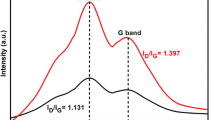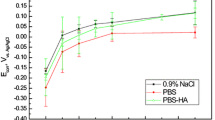Abstract
The field of medical implants in the human body is a growing area with diverse tribological aspects. This application field has its own specific characteristics, dominated by stringent quality requirements due to the human suffering and sometimes life-threatening consequences of a surface failing to fulfil its required function. Combined wear–corrosion tests could provide more complete information about the implant behaviour in the aggressive body environment than separate wear and corrosion testing. Combined wear–corrosion experiments were performed using a reciprocating ball-on-plate apparatus equipped with an electrochemical cell. Untreated CoCrMo alloy samples as well as diamond-like carbon (DLC) coated samples were used as plate. The DLC coatings were tested with three different surface finishes: as-deposited, polished with diamond and brushed. All DLC coated samples with and without mechanical finishing had lower corrosion activity under wear–corrosion conditions and also smaller wear tracks when compared with the CoCrMo alloy. The current density for the coated alloy was about two orders of magnitude lower on average (10−5 vs. 10−3 A cm−2) and had a final coefficient of friction of only 50% of the uncoated metal (0.15 vs. 0.3). The brushed DLC showed the lowest current density and its behaviour was better than polished DLC and DLC as-deposited up to a potential of +0.93 V.










Similar content being viewed by others
References
Jacobs, J.J., Skipor, A.K., Black, J., Urban, R.M., Galante, J.O.: Release and excretion of metal in patients who have a total hip replacement component made of titanium-base alloy. J. Bone Joint Surg. 73, 1475–1486 (1991)
Jacobs, J.J., Skipor, A.K., Patterson, L.M., Hallab, N.J., Paprosky, W.G., Black, J., Galante, J.O.: Metal release in patients who have had a primary total hip arthroplasty. J. Bone Joint Surg. 80, 1447–1458 (1998)
Jacobs, J.J., Silverton, C., Hallab, N.J., Skipor, A.K., Patterson, L., Black, J., Galante, J.O.: Metal release and excretion from cement-less titanium alloy total knee replacements. Clin. Orthop. Relat. Res. 358, 173–180 (1999)
Wise, D.L.: Biomaterials and bioengineering handbook. Dekker, New York (2000)
Sunderman Jr, F.W., Hopfer, S.M., Swift, T., Rezuke, W.N., Ziebka, L., Highman, P., Edwards, B., Folcik, M., Gossling, H.R.: Cobalt, chromium, and nickel concentrations in body fluids of patients with porous-coated knee or hip prostheses. J. Orthop. Res. 7, 307–315 (1989)
Liu, T.K., Liu, S.H., Shang, C.H., Yang, R.S.: Concentration of metal elements in the blood and urine in the patients with cement-less total knee arthroplasty. Tohoku J. Exp. Med. 185, 253–262 (1998)
Okazakia, Y., Gotohb, E.: Comparison of metal release from various metallic biomaterials in vitro. Biomaterials 26, 11–21 (2005)
Hanawa, T.: In vivo metallic biomaterials and surface modification. Mater. Sci. Eng. A 267, 260–266 (1999)
Yan, Y., Neville, A., Dowson, D.: Understanding the role of corrosion in the degradation of metal-on-metal implants. Proc. Inst. Mech. Eng. Part H: J. Eng. Med. 220, 173–180 (2006)
Hsua, R.W.W., Yang, C.-C., Huangc, C.A., Chenb, Y.-S.: Electrochemical corrosion studies on Co–Cr–Mo implant alloy in biological solutions. Mater. Chem. Phys. 93, 531–538 (2005)
Contu, F., Elsene, B., Bohni, H.: Corrosion behaviour of CoCrMo implant alloy during fretting in bovine serum. Corros. Sci. 47, 1863–1875 (2005)
Yan, Y., Neville, A., Dowson, D.: Tribo-corrosion properties of cobalt-based medical implant alloys in simulated biological environments. Wear 263, 1105–1111 (2007)
Dearnley, P.A.: A brief review of test methodologies for surface-engineered biomedical implant alloys. Surf. Coat. Technol. 198, 483–490 (2005)
Grant, D.M., Mccoll, I.R., Golozar, M.A., Wood, J.V., Braithwaite, N.St.J.: Plasma assisted CVD for biomedical applications. Diam. Relat. Mater. 1, 727–730 (1992)
Mitura, E., Mitura, S., Niedzielski, P., Has, Z., Wolowiec, R., Jakubowski, A., Szmidt, J., Sokolowska, A., Louda, P., Marciniak, J., Koczy, B.: DLC coatings for biomedical applications. Diam. Relat. Mater. 3, 896–898 (1994)
Marciniak, L., Koczy, B., Boba, S., Mitura, S.: Einfluss von Passivirungs- und Kohlenstoffschichten auf austenitischen CrNiMo-Stahlen auf die Beständigkeit gegen Lochfrass und Spannungsrisskorrosion. Werkstoffe und Korrosion 44, 379–383 (1993)
Thomson, L.A., Law, F.C., Rushton, N., Franks, J.: Biocompatibility of diamond-like carbon coating. Biomaterials 12, 37–40 (1991)
Tiainen, V.M.: Amorphous carbon as a bio-mechanical coating—mechanical properties and biological applications. Diam. Relat. Mater. 10, 153–160 (2001)
Liu, E., Kwek, H.W.: Electrochemical performance of diamond-like carbon thin films. Thin Solid Films 516, 5201–5205 (2008)
Mitura, E., Niedzielska, A., Niedzielski, P., Klimek, L., Rylski, A., Mitura, S., Moll, J., Pietrzykowski, W.: The properties of carbon layers deposited onto titanium substrates. Diam. Relat. Mater. 5, 998–1001 (1996)
Fewell, M.P., Mitchell, D.R.G., Priest, J.M., Short, K.T., Collins, G.A.: The nature of expanded austenite. Surf. Coat. Technol. 131, 300–306 (2000)
Marchev, K., Cooper, C.V., Blucher, J.T., Giessen, C.B.: Conditions for the formation of a martensitic single-phase compound layer in ion-nitrided 316L austenitic stainless steel. Surf. Coat. Technol. 99, 225–228 (1998)
Uzumaki, E.T., Lambert, C.S., Belangero, W.D., Freire, C.M.A., Zavaglia, C.A.C.: Evaluation of diamond-like carbon coatings produced by plasma immersion for orthopaedic applications. Diam. Relat. Mater. 15, 982–988 (2006)
Noli, F., Misaelides, P., Riviere, J.P.: Enhancement of the corrosion resistance of a Ti-based alloy by ion beam deposition methods. Nucl. Instrum. Methods Phys. Res. B 267, 1670–1674 (2009)
Dorner-Reisela, A., Schürer, C., Irmer, G., Müller, E.: Electrochemical corrosion behaviour of uncoated and DLC coated medical grade Co28Cr6Mo. Surf. Coat. Technol. 177–178, 830–837 (2004)
Lakatos-Varsanyi, M., Darko, H.: Cyclic voltammetry measurement of different single-, bi- and multilayer TiN and single layer CrN coatings on low-carbon-steel substrates. Corros. Sci. 41, 1585–1598 (1998)
Landolt, D., Mischler, S., Stemp, M.: Electrochemical methods in tribocorrosion: a critical appraisal. Electrochim. Acta 46, 3919–3929 (2001)
Manhabosco, T.M., Müller, I.L.: Tribocorrosion of diamond-like carbon deposited on Ti6Al4V. Tribol. Lett. 33, 193–197 (2009)
Galliano, F., Galvanetto, E., Mischler, S., Landolt, D.: Tribocorrosion behavior of plasma nitrided Ti–6Al–4V alloy in neutral NaCl solution. Surf. Coat. Technol. 145, 121–131 (2001)
Watson, S.W., Friedesdorf, F.J., Madsen, B.W., Cramer, S.D.: Methods of measuring wear–corrosion synergism. Wear 181–183, 476–484 (1995)
Songbo, Y., Li, D.Y.: A new phenomenon observed in determining the wear–corrosion synergy during a corrosive sliding wear test. Tribol. Lett. 29, 45–52 (2007)
Gurappa, I.: Characterization of different materials for corrosion resistance under simulated body fluid conditions. Mater. Charact. 49, 73–79 (2002)
Vidal, C.V., Muñoz, A.I.: Electrochemical characterisation of biomedical alloys for surgical implants in simulated body fluids. Corros. Sci. 50, 1954–1961 (2008)
Landolt, D., Mischler, S., Stemp, M., Barril, S.: Third body effects and material fluxes in tribocorrosion systems involving a sliding contact. Wear 256, 517–524 (2004)
Azzia, M., Paquette, M., Szpunar, J.A., Klemberg-Sapieha, J.E., Martinu, L.: Tribocorrosion behaviour of DLC-coated 316L stainless steel. Wear 267, 860–866 (2009)
Author information
Authors and Affiliations
Corresponding author
Rights and permissions
About this article
Cite this article
Santos, C.B., Haubold, L., Holeczek, H. et al. Wear–Corrosion Resistance of DLC/CoCrMo System for Medical Implants with Different Surface Finishing. Tribol Lett 37, 251–259 (2010). https://doi.org/10.1007/s11249-009-9501-z
Received:
Accepted:
Published:
Issue Date:
DOI: https://doi.org/10.1007/s11249-009-9501-z




